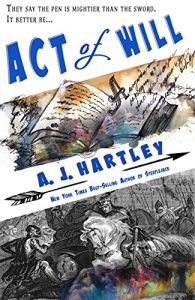I’ve written about politics and social issues a lot in recent weeks, and I want desperately to avoid doing so again this week. It’s not that I don’t have more to say. I do. But I feel as though I’d be going over familiar ground, raising the same objections to this Administration, calling attention to new outrages and failings that are simply echoes of the older ones I’ve already criticized. I am weary of outrage, sick to death of this campaign, ready to reclaim the emotional energy and brain space I’ve ceded to it for so many months.
There is more to life than this. I know there is, and recently, as I have pulled back from political websites and social media, I have been taking pleasure in the small things that I enjoy most. Here’s how I’m coping:
Music: Making music and listening to it. The former has been particularly rewarding because for a time earlier this year, a shoulder issue — terribly painful, basically untreatable except for physical therapy, but not truly serious — kept me from being able to play my guitars. I am happy to report that my shoulder, while not 100%, is much better. I’m playing again, learning new songs, building up strength in my arm and hand. Again, I’m not all the way there, but I’m playing again, and that gives me such pleasure.
I’m also listening a lot, mostly to old rock, even when I’m working. In the past, some of you know, I have strictly limited my work-time listening to instrumental music — jazz and bluegrass mostly. But somehow, right now, with all that’s going on in my head, I am able to work and listen to rock at the same time. I honestly don’t know why, but I’m not complaining.
Work: I’m getting work done on several projects, which is gratifying. I have been working on a pair of trunk novels, one that needed editing, and its sequel, which needed editing and an ending. I’m making good progress on those, but I am not pushing myself too hard, and that seems to be a good thing. I’m the first to admit that I am not at my best right now. So rather than beat myself up for not being efficient, I am accepting the limitations imposed by my current emotional state. I work when I can, and when the work doesn’t flow, I take care of other things, be they work-related or house-related or whatever.
I also have a novel that my agent and I are trying to sell and a set of Thieftaker novellas that are in production. And I have other projects at various stages of completion and readiness. On the one hand, I’m impatient for forward motion on all of them. At the same time, I understand that I can only do so much, and that the publishing world is moving even more slowly than usual. I am doing my best to be patient, something that doesn’t come naturally to me.
Getting outside: Fall has been brilliant this year here on the Cumberland Plateau. Shimmering, clear days, cool nights, stunning mornings. I have been birdwatching, savoring my morning walks, taking extra hikes later in the day, taking photos, and generally forcing myself to get away from my computer. Idle moments at my desk lead me to bad habits — social media, political sites, etc. In short, all the stuff I’m trying to avoid. To the extent possible, when the siren call of the web grows too strong, I escape it by going outside and doing something else.
Comfort food for the brain: Throughout the pandemic, I have found it hard to read. Except for political journalism, which, of course, I want no part of right now. The exception is old favorite novels by authors I love. So I’ve been re-reading the works of Guy Gavriel Kay, and have it in mind to read some other old works after that. They are comforting and comfortable, which I really need right now.
Along the same lines, I have been enjoying the television shows of Aaron Sorkin. Most of you probably know about The West Wing and The Newsroom, and I’ve been watching plenty of West Wing, happily retreating to a world in which Jed Bartlet is President. I have also been watching Sports Night, a short-lived half-hour comedy/drama that aired for two years before being cancelled. It was a terrific show about a sports show along the lines of ESPN’s Sportscenter. It was funny and poignant and smart, like all of Sorkin’s work. The network never knew what to do with the show. They tried a laugh track with it for a while, but that didn’t work. And by the time they figured out that they just needed to leave it alone, the show had been mired in a ratings slump for too long to be saved. If you can find the disks, I recommend it highly, particularly season 1.
Nancy: The one constant for me during this pandemic is that Nancy and I have enjoyed our time together. We have been cooking a lot, taking walks together, sipping whisky on the front porch as the sun goes down, and generally counting ourselves so very fortunate to have each other. There’s really not much more to say about this, but as I struggle to maintain my emotional health, I have to acknowledged that I would have broken a long time ago if not for her.
I know how lucky I am — lucky to play guitar, to have music at my disposal, to have a job I love, to have books to read and old DVDs to watch, to live in a place that is beautiful and that offers easy access to wilderness, to have a happy marriage. Please believe that I take none of this for granted. That wasn’t always the case, but this year has shown me the folly of doing so. I won’t fall prey to that particular mistake again.
I wish you health — emotional and physical — and I hope you have a wonderful week. See you Wednesday.









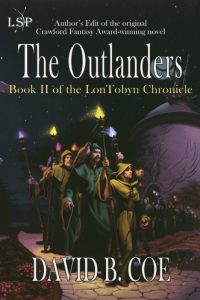 My first book, Children of Amarid, was a fairly standard epic fantasy, though it had the seeds of more within the nuances of its plot. It was my second novel, though, The Outlanders, that convinced me I could succeed as a writer. The reason was, that second book was different. It introduced a technological, crime-ridden world unlike anything I’d ever tried writing. It created an unusual dynamic among three of my lead characters — two of the characters, who were allies, spoke different languages, and they had to rely on the third for translation. But neither of them trusted that third character.
My first book, Children of Amarid, was a fairly standard epic fantasy, though it had the seeds of more within the nuances of its plot. It was my second novel, though, The Outlanders, that convinced me I could succeed as a writer. The reason was, that second book was different. It introduced a technological, crime-ridden world unlike anything I’d ever tried writing. It created an unusual dynamic among three of my lead characters — two of the characters, who were allies, spoke different languages, and they had to rely on the third for translation. But neither of them trusted that third character.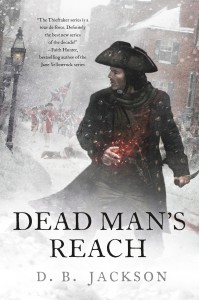 Still, I can say this: It’s easy to grow attached to one particular franchise, one particularly world and set of characters and style of story. Certainly I have written a good deal in the Thieftaker world, and will soon be coming out with new work about Ethan Kaille, Sephira Pryce, et al. The fact is, though, each time I have moved on to a new project, I have tried (admittedly with varying degrees of success) to challenge myself, to force myself to grow.
Still, I can say this: It’s easy to grow attached to one particular franchise, one particularly world and set of characters and style of story. Certainly I have written a good deal in the Thieftaker world, and will soon be coming out with new work about Ethan Kaille, Sephira Pryce, et al. The fact is, though, each time I have moved on to a new project, I have tried (admittedly with varying degrees of success) to challenge myself, to force myself to grow.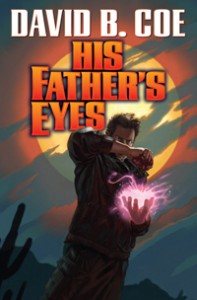 After the LonTobyn books, I moved to Winds of the Forelands and Blood of the Southlands, which demanded far more sophisticated world building and character work. After those, I turned to Thieftaker, adding historical and mystery elements to my storytelling and limiting my point of view to a single character. I also started working on the Justis Fearsson books, which explored mental health issues and were my first forays into writing in a contemporary setting. Then I took on the Islevale books, time travel/epic fantasies that presented the most difficult plotting issues I’ve ever faced.
After the LonTobyn books, I moved to Winds of the Forelands and Blood of the Southlands, which demanded far more sophisticated world building and character work. After those, I turned to Thieftaker, adding historical and mystery elements to my storytelling and limiting my point of view to a single character. I also started working on the Justis Fearsson books, which explored mental health issues and were my first forays into writing in a contemporary setting. Then I took on the Islevale books, time travel/epic fantasies that presented the most difficult plotting issues I’ve ever faced.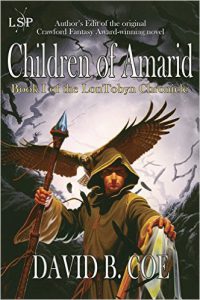 I believe my action scenes are pretty effective, and, actually, I would say the same about my sex scenes. But that wasn’t always the case. In the first draft of my very first novel, Children of Amarid, I wrote a sex scene that my editor tore apart. And with good reason. While the rest of the narrative worked pretty well, the sex scene felt completely staged and out of character. And the reason was quite simple: For that one encounter, I forgot about my characters’ points of view and tried to write a sex scene that felt, well, sexy. That didn’t work, because my characters were young and in love, but also inexperienced and still a little awkward with each other. None of that came through in the writing.
I believe my action scenes are pretty effective, and, actually, I would say the same about my sex scenes. But that wasn’t always the case. In the first draft of my very first novel, Children of Amarid, I wrote a sex scene that my editor tore apart. And with good reason. While the rest of the narrative worked pretty well, the sex scene felt completely staged and out of character. And the reason was quite simple: For that one encounter, I forgot about my characters’ points of view and tried to write a sex scene that felt, well, sexy. That didn’t work, because my characters were young and in love, but also inexperienced and still a little awkward with each other. None of that came through in the writing.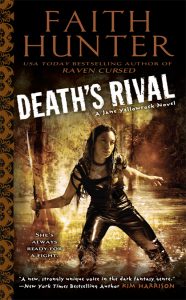 In the same way, action scenes – fight scenes, battle scenes, violent scenes; whatever you want to call them – also hinge on the qualities, histories, experiences, and emotions of our point of view characters. A seasoned fighter, someone who makes their living in a violent world or who was brought up to be a warrior, is going to experience violence quite differently from, well, someone like me, who has little knowledge of fighting technique and scant history with violence and bloodshed. The practiced fighter’s point of view might sound almost clinical – this person will know how to control emotion, how to draw upon skills and observations learned over years of training. The novice’s point of view should come off as far more desperate, fearful, overwhelmed by the frenzy of violence in which they find themselves. Again, point of view is all. One is not necessarily more exciting to read than the other – think of the battle scenes in Faith Hunter’s thrilling, New York Times Bestselling Jane Yellowrock books and in A.J. Hartley’s wonderful Will Hawthorne novels, which are not only entertaining but also a master class in writing voice. Jane is a warrior; Will is SO not.. The scenes in both make for compelling reading, but they couldn’t be more different.
In the same way, action scenes – fight scenes, battle scenes, violent scenes; whatever you want to call them – also hinge on the qualities, histories, experiences, and emotions of our point of view characters. A seasoned fighter, someone who makes their living in a violent world or who was brought up to be a warrior, is going to experience violence quite differently from, well, someone like me, who has little knowledge of fighting technique and scant history with violence and bloodshed. The practiced fighter’s point of view might sound almost clinical – this person will know how to control emotion, how to draw upon skills and observations learned over years of training. The novice’s point of view should come off as far more desperate, fearful, overwhelmed by the frenzy of violence in which they find themselves. Again, point of view is all. One is not necessarily more exciting to read than the other – think of the battle scenes in Faith Hunter’s thrilling, New York Times Bestselling Jane Yellowrock books and in A.J. Hartley’s wonderful Will Hawthorne novels, which are not only entertaining but also a master class in writing voice. Jane is a warrior; Will is SO not.. The scenes in both make for compelling reading, but they couldn’t be more different.